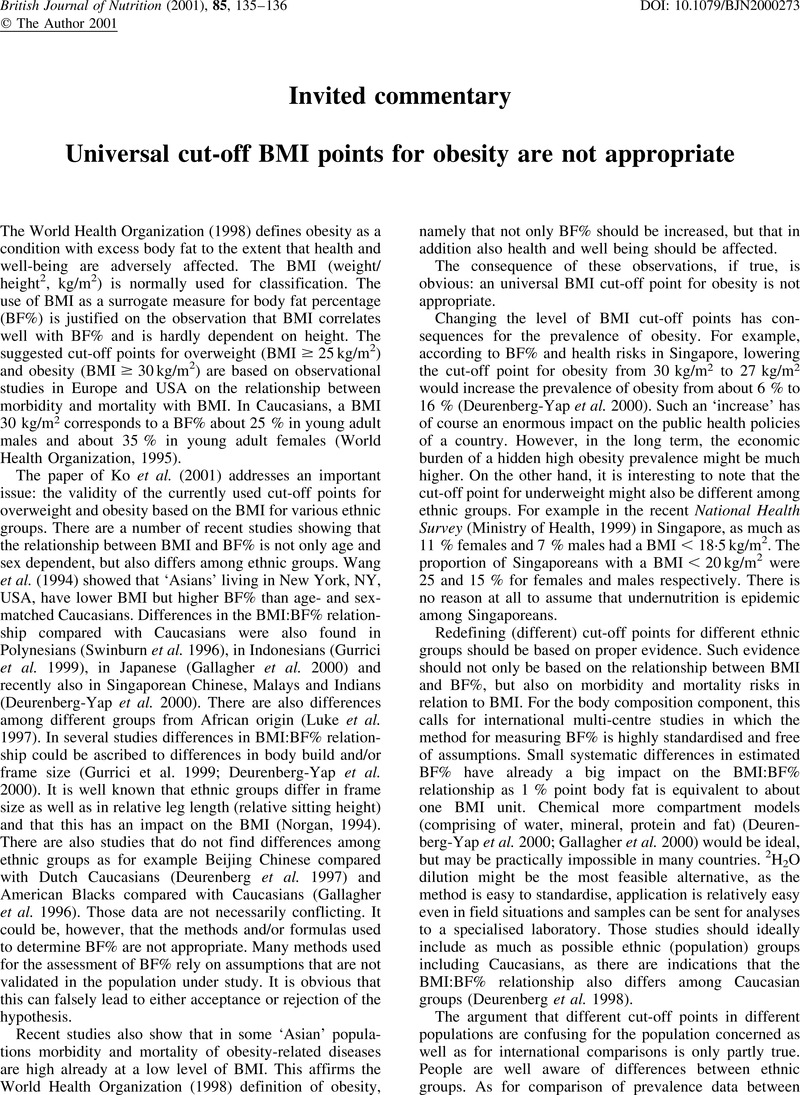Crossref Citations
This article has been cited by the following publications. This list is generated based on data provided by Crossref.
Deurenberg, Paul
and
Deurenberg-Yap, Mabel
2001.
Differences in body-composition assumptions across ethnic groups: practical consequences.
Current Opinion in Clinical Nutrition and Metabolic Care,
Vol. 4,
Issue. 5,
p.
377.
Schutz, Y
Kyle, UUG
and
Pichard, C
2002.
Fat-free mass index and fat mass index percentiles in Caucasians aged 18–98 y.
International Journal of Obesity,
Vol. 26,
Issue. 7,
p.
953.
Hamilton, Michael
2002.
Strategies for the Management of Patients with Obesity.
Treatments in Endocrinology,
Vol. 1,
Issue. 1,
p.
21.
Johansson‐Kark, M
Rasmussen, F
and
Hjern, A
2002.
Overweight among international adoptees in Sweden: a population‐based study.
Acta Paediatrica,
Vol. 91,
Issue. 7,
p.
827.
Reilly, John J.
2002.
Assessment of Childhood Obesity: National Reference Data or International Approach?.
Obesity Research,
Vol. 10,
Issue. 8,
p.
838.
Caterson, Ian D
and
Gill, Timothy P
2002.
Obesity: epidemiology and possible prevention.
Best Practice & Research Clinical Endocrinology & Metabolism,
Vol. 16,
Issue. 4,
p.
595.
Deurenberg, P
Deurenberg-Yap, M
Foo, L F
Schmidt, G
and
Wang, J
2003.
Differences in body composition between Singapore Chinese, Beijing Chinese and Dutch children.
European Journal of Clinical Nutrition,
Vol. 57,
Issue. 3,
p.
405.
Hamilton, Michael
and
Lovejoy, Jennifer
2003.
Nutritional Concerns of Women, Second Edition.
Vol. 20032636,
Issue. ,
p.
133.
Fu, W P C
Lee, H C
Ng, C J
Tay, Y-K D
Kau, C Y
Seow, C J
Siak, J K
and
Hong, C Y
2003.
Screening for childhood obesity: international vs population-specific definitions. Which is more appropriate?.
International Journal of Obesity,
Vol. 27,
Issue. 9,
p.
1121.
Kagawa, M
Kerr, D
and
Binns, C
2003.
Ethnic Differences in the BMI-%BF Relationships between Young Japanese and Australian-Caucasian Males Living in Australia Using Dual-Energy X-ray Absorptiometry.
Asia Pacific Journal of Public Health,
Vol. 15,
Issue. 1_suppl,
p.
S27.
Vázquez, C.
2003.
La grasa como factor de riesgo de obesidad en la población infantil.
Endocrinología y Nutrición,
Vol. 50,
Issue. 6,
p.
198.
Erondu, Ngozi E.
2003.
Early Diagnosis and Treatment of Endocrine Disorders.
p.
123.
Greenway, Frank
and
Hamilton, Michael
2004.
Pharmacotherapy of Obesity.
p.
87.
Kim, Dol Mi
and
Ahn, Chul Woo
2004.
Definition and Epidemiology of Obesity.
Journal of the Korean Medical Association,
Vol. 47,
Issue. 4,
p.
289.
Wang, Y
2004.
Epidemiology of childhood obesity—methodological aspects and guidelines: what is new?.
International Journal of Obesity,
Vol. 28,
Issue. S3,
p.
S21.
Sykes, Kevin
Choo, Lau Leong
and
Cotterrell, Mary
2004.
Accumulating aerobic exercise for effective weight control.
Journal of the Royal Society for the Promotion of Health,
Vol. 124,
Issue. 1,
p.
24.
Garcia, Ada L.
Wagner, Karen
Hothorn, Torsten
Koebnick, Corinna
Zunft, Hans‐Joachim F.
and
Trippo, Ulrike
2005.
Improved Prediction of Body Fat by Measuring Skinfold Thickness, Circumferences, and Bone Breadths.
Obesity Research,
Vol. 13,
Issue. 3,
p.
626.
Misra, Anoop
Wasir, Jasjeet S.
and
Vikram, Naval K.
2005.
Waist circumference criteria for the diagnosis of abdominal obesity are not applicable uniformly to all populations and ethnic groups.
Nutrition,
Vol. 21,
Issue. 9,
p.
969.
Loke, Alice Yuen
and
Chan, Kit Nga
2005.
Dietary habits of patients with coronary atherosclerosis: case–control study.
Journal of Advanced Nursing,
Vol. 52,
Issue. 2,
p.
159.
Yoo, S
Lee, S-Y
Kim, K-N
and
Sung, E
2006.
Obesity in Korean pre-adolescent school children: comparison of various anthropometric measurements based on bioelectrical impedance analysis.
International Journal of Obesity,
Vol. 30,
Issue. 7,
p.
1086.



